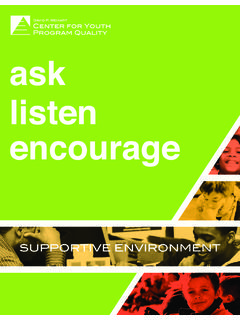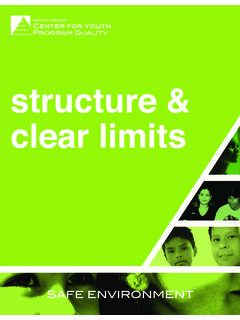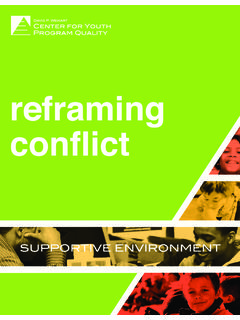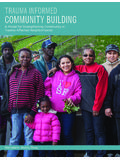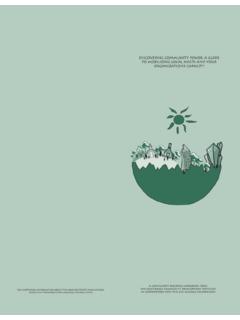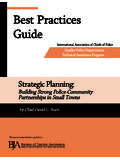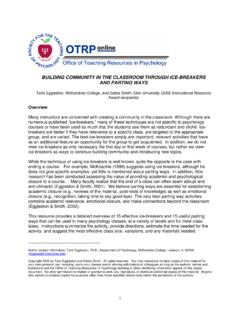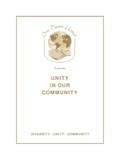Transcription of e David P. Weikart Center for Youth Program #uality,
1 ! " # $ % & ' ( # ) ! * +. ! " # $ % & ' ( # ) ! * +. The David P. Weikart Center for Youth Program Quality, , - . / . 0 . 1 2 1 3 4 5 6 7 1 8 9 : 3 1 8 ; 1 9 4 5 < 2 / 6 0 4 : 6 2 4 = . 0 - 6 - . > , 4 6 - 4 1 6 : ? 1 @ 6 8 . 2 A 6 - 9 > , 4 . 1 2 , 2 - 5 9 : , 2 0 6 8 / . > 6 B 6 , - 6 8 0 4 1 , - , ? 4 = . : ? B 6 : 6 2 4 = , 2 - 0 > , B 6 C 6 0 4 D . 2 D > B , 0 0 = 8 6 0 6 , 8 > 5 D / , B . - , 4 6 - E 9 , B . 4 F . : ? 8 1 / 6 : 6 2 4 0 F 0 4 6 : 0 4 1 , - / , 2 > 6 > 5 . B - , 2 - F 1 9 4 5 - 6 / 6 B 1 ? : 6 2 4 G H 5 6 I 6 . J , 8 4 K 6 2 4 6 8. 6 2 > 1 9 8 , A 6 0 : , 2 , A 6 8 0 4 1 ? 8 . 1 8 . 4 . L 6 ? 8 1 A 8 , : E 9 , B . 4 F G I 6 1 3 3 6 8 4 8 , . 2 . 2 A = 4 6 > 5 2 . > , B , 0 0 . 0 4 , 2 > 6 =. , 2 - 8 6 0 6 , 8 > 5 0 6 8 / . > 6 0 4 5 , 4 , B B > 1 : 6 4 1 A 6 4 5 6 8 . 2 4 5 6 ; 1 9 4 5 M 8 1 A 8 , : N 9 , B.
2 4 F < 2 4 6 8 / 6 2 4 . 1 2 = , > 1 : ? 8 6 5 6 2 0 . / 6 0 F 0 4 6 : 3 1 8 . : ? 8 1 / . 2 A 4 5 6 E 9 , B . 4 F 1 3 F 1 9 4 5 ? 8 1 A 8 , : 0 G. Bringing together over fifty years of experience and the latest research, 4 5 6 ; 1 9 4 5 I 1 8 J O 6 4 5 1 - 0 , 8 6 ? 8 1 / 6 2 0 4 8 , 4 6 A . 6 0 3 1 8 @ 1 8 J . 2 A @ . 4 5 F 1 9 4 5 G I 5 6 4 5 6 8 F 1 9 C 6 B . 6 / 6. 4 5 , 4 4 5 6 ? 9 8 ? 1 0 6 1 3 , 2 1 9 4 D 1 3 D 0 > 5 1 1 B 4 . : 6 ? 8 1 A 8 , : . 0 4 1 . : ? 8 1 / 6 , > , - 6 : . > 0 = 4 1 C 9 . B - B . 3 6 0 J . B B 0 =. 1 8 P 9 0 4 4 1 ? 8 1 / . - 6 , ? B , > 6 @ 5 6 8 6 J . - 0 > , 2 5 , 2 A 1 9 4 , 2 - C 6 J . - 0 = 4 5 6 , ? ? 8 1 , > 5 ? 8 6 0 6 2 4 6 - . 2 4 5 6. ; 1 9 4 5 I 1 8 J O 6 4 5 1 - 0 0 6 8 . 6 0 ? 8 1 / . - 6 0 , 3 1 9 2 - , 4 . 1 2 3 1 8 C 9 . B - . 2 A 0 , 3 6 , 2 - ? 8 1 - 9 > 4.
3 / 6 ? B , > 6 0 3 1 8. F 1 9 4 5 G. Q R S T U V W X R V T Y Z S T U [ T \ ] [ ] ^ _ _ _ ` a b Z c ` R V d `. Tom Akiva & Gina McGovern ! " # $ ! % ! % # & # ' ( ) * + , , - . / /. 0 1 ' % 2 3 ! % 4 5 & 6 ! 7 + " # % 0 8 9 ! # : + 1 & ; ! ( & ! 1 < ' 1 = ' 2 & 6 0 1 ' > 1 + ? @ 2 + , # & 5 ) + % # " # $ # ' ( ' < A 6 ! * ' 1 2 ? < ' 1 = ' 2 & 6 B ( " ! $ & ? ! ( & 8. C - . / / A 6 ! * ' 1 2 ? < ' 1 = ' 2 & 6 B ( " ! $ & ? ! ( & 8 D , , # > 6 & $ 1 ! $ ! 1 " ! % 8 0 + 1 & $ ' < & 6 # $ 1 ! E ' 1 & ? + 5 4 ! F 2 ' & ! %. ' 1 2 $ ! % + $ , ' ( > + $ & 6 ! + 2 & 6 ' 1 $ + ( % & 6 ! * ' 1 2 ? < ' 1 = ' 2 & 6 B ( " ! $ & ? ! ( & + 1 ! 1 ! 3 ' > ( # G ! % 8 H ' E + 1 & ' < & 6 # $. E 2 4 , # 3 + & # ' ( ? + 5 4 ! 1 ! E 1 ' % 2 3 ! % ' 1 & 1 + ( $ ? # & & ! % < ' 1 3 ' ? ? ! 1 3 # + , E 2 1 E ' $ ! $ I # & 6 ' 2 & E 1 # ' 1 E !))))))))))))
4 1 ? # $ $ # ' (. < 1 ' ? & 6 ! * ' 1 2 ? < ' 1 = ' 2 & 6 B ( " ! $ & ? ! ( & 8. * ' 1 < 2 1 & 6 ! 1 # ( < ' 1 ? + & # ' ( ' 1 & ' 1 ! F 2 ! $ & E ! 1 ? # $ $ # ' ( $ ) E , ! + $ ! 3 ' ( & + 3 & & 6 ! 7 + " # % 0 8 9 ! # : + 1 & ; ! ( & ! 1. < ' 1 = ' 2 & 6 0 1 ' > 1 + ? @ 2 + , # & 5 + & / - J 0 ! + 1 , K & 1 ! ! & ) K 2 # & ! L . / ) = E $ # , + ( & # ) M # 3 6 # > + ( J N / O P 8. 0 6 ' ( ! Q P R J 8 O L / 8 L O .. 8 S ? + # , Q # ( < ' T 3 5 E F 8 ' 1 > 8 9 ! 4 Q I I I 8 3 5 E F 8 ' 1 >. David P. Weikart Center for Youth Program Quality Acknowledgments ! " # $ % & ! ' " ( " ) $ * + " , & - * * . $ - / ! ' " 0 / . 1 2 " ' 1 , & ! " 0 " * - 3 " 0 4 - 0 $ . 1 3 1 , - ) ) # ' " ( " ) $ * " ' - , '. & " 0 & " ' - & & ! " 5 1 3 ! 6 / $ * " 6 % + + " . 7 $ . 8 0 ! $ * 9 $ . " " , 0 : 9 $ % , ' " ' 1 , ; < = > ?))))))
5 @ ) - & " . / - ) ) " ' & ! ". A , 0 & 1 & % & " 9 $ . A B C D 6 E A , & ! " ) - < < F 0 5 1 3 ! 6 / $ * " G 0 H $ % & ! B " ( " ) $ * + " , & I . $ % * & $ $ 8 & ! ". ) " - . , 1 , 3 - * * . $ - / ! ' " ( " ) $ * " ' - & & ! " A , 0 & 1 & % & " 9 $ . A B C D 6 - , ' ' " ) 1 ( " . " ' & . - 1 , 1 , 3 9 $ . # $ % & ! 4 $ . 8 " . 0 E ! " 0 " 4 $ . 8 0 ! $ * 0 @ 3 . $ % , ' " ' 1 , 5 1 3 ! 6 / $ * " J 0 ' 1 . " / & " K * " . 1 " , / " @ 4 " . " " K & " , ' " ' 2 #. & ! " B - ( 1 ' L E 7 " 1 8 - . & M " , & " . 9 $ . H $ % & ! L . $ 3 . - + N % - ) 1 & # & ! . $ % 3 ! . " 0 " - . / ! 1 , * $ 0 1 & 1 ( " # $ % & ! ' " ( " ) $ * + " , & - , ' " ( $ ) ( " ' 1 , & $ 4 ! - & 1 0 / % .. " , & ) # $ % . H $ % & ! 7 $ . 8 O " & ! $ ' 0 0 " . 1 " 0 E. ! " / % .. " , & & . - 1 , 1 , 3 9 . - + " 4 $ . 8 . " 0 & 0 $ , - 9 $ % , ' - & 1 $ , ' " ( " ) $ * " ' 2 # + - , # @ 1 , / ) % ' 1 , 3 B - ( 1 ' L E.
6 7 " 1 8 - . & @ P 1 / $ ) " H $ ! - ) " + @ Q $ ! , 7 " 1 0 0 @ R " / 8 # L . 1 $ . @ S 1 8 % Q $ ! , 0 $ , @ D - . $ , 7 1 ) 0 $ , T D ! ) 0 & . $ + U U. - " , , " ! $ + * 0 $ , @ $ + D 8 1 ( - @ D ) 1 / 1 - 7 1 ) 0 $ , T D ! ) 0 & . $ + @ B - ( 1 ' O - . & 1 , " - % @ 1 , ' - 5 $ . , " @ O - . #. 5 $ ! + - , , @ M ! - . ) " 0 5 $ ! + - , , @ M ! - . ) " 0 6 + 1 & ! @ O $ , 1 / - Q $ , " 0 @ - , ' + - , # $ & ! " . 0 E. ! " 7 " 1 8 - . & M " , & " . 4 $ % ) ' - ) 0 $ ) 1 8 " & $ & ! - , 8 & ! " V - 1 8 " 0 W $ % , ' - & 1 $ , @ 9 $ . * . $ ( 1 ' 1 , 3 9 % , ' 1 , 3. 9 $ . & ! " . " ( 1 0 1 $ , $ 9 & ! 1 0 0 " . 1 " 0 X & ! " V $ 2 " . & 7 $ $ ' Q $ ! , 0 $ , 9 $ % , ' - & 1 $ , 9 $ . * . $ ( 1 ' 1 , 3 9 % , ' 1 , 3 9 $ . & ! " ' " ( " ) $ * + " , & $ 9 & ! " $ . 1 3 1 , - ) H $ % & ! 7 $ . 8 O " & ! $ ' 0 0 ".
7 1 " 0 X - , ' & ! " 5 1 3 ! 6 / $ * " C ' % / - & 1 $ , - ). V " 0 " - . / ! W $ % , ' - & 1 $ , @ $ % . $ . 1 3 1 , - ) * - . " , & $ . 3 - , 1 Y - & 1 $ , E. table of contents Introduction 1. Why Build community ? 2. The Method 5. Overview 6. Create Avenues for community building 7. Be Involved And Mindful 9. Don t Leave Anyone Out 11. Promote Respect For Diversity 12. Extensions 15. Stages Of Group Development 16. Across Age Groups 19. Across Content Areas 20. In Your Program 23. Planning for community - building 24. Sharing building community With Others 26. Group Games 29. How to Use This Section 30. Listing of Group Games 32. Resources 89. Research Review 90. building community and the Active-Participatory Approach 96. why build community ? building community in a Youth Program is important for many reasons.
8 A strong, welcome community can help young people feel safe, feel a sense of belonging, and build their sense of selves within the group. Even beyond these personal growth areas, a strong Program community can create an environment in which learning can better Here are four good reasons to build community . Increase participation and attendance A strong community can Feelings of belonging in a productive group environment can lead to improved participation and Help young people feel that they belong attendance. This can be more noticeable in Youth Researchers argue that sense of belonging is programs than in school since Youth programs are a fundamental human need; that is, everybody usually voluntary. If a Youth doesn t feel part of a wants to feel like they belong. Additionally, in most community , why would they want to come back?
9 Cases, students who feel a sense of belonging in school tend to do better academically. That s Increase student learning probably why the National Research Council lists Finally, building community can lead to opportunities to belong as a key feature of positive increased student learning, whether your focus development settings. is on academics, enrichment, or broader learning goals. This is true in schools and it is true in Youth Help groups get along and be productive programs . When Youth feel safety and belonging, Groups go through normal stages in their they are in a good position to learn. development (see page 16). When you intentionally support positive group development in your Program , The strategies presented in this guidebook are it can lead to groups that function better and more designed to help you help your Youth feel like smoothly which is good news for everybody!
10 They belong, to help groups get along and be productive, and ultimately to improve their participation and learning. 1. -VY H YL]PL^ VM [OL ZJPLU[P J SP[LYH[\YL ILOPUK [OLZL JSHPTZ WSLHZL ZLL . pages 90-95. 2 | Send any comments about this guidebook or Method to: overview What is building community ? building community focuses on promoting a climate in which Youth can feel part of a group. community building can take place in both structured and unstructured ways. Structured avenues include welcomes, icebreakers, problem-solving games, trust games, name games, and partner activities. Unstructured venues such as transition times are also contexts in which community building can occur. The building community Method shares some similarities with the Weikart Center Cooperative Learning Method; however, the two are distinct.]]]]
